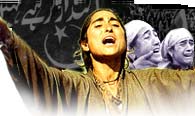THE CHIEF MINISTERS
Sheikh Mohammad Abdullah

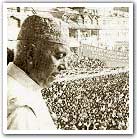
He wanted to be a doctor. Instead he became a schoolteacher, then turned politician, and founded the Muslim Conference, National Conference and the Plebiscite Front, in that order.
Undoubtedly the most towering personality in Kashmir's history, Sheikh Abdullah fathered the Quit Kashmir Movement of 1946. "Sovereignty is not the birthright of Maharaja Hari Singh. Quit Kashmir is not a question of revolt. It is a matter of right," he proclaimed.
Promptly, the maharaja's men threw him into jail, from where he emerged only in September 1947. That, thanks to pressure from his close friend, Prime Minister Jawaharlal Nehru.
Sheikh Abdullah's stand was that Hari Singh had no right to decide the Kashmiris' future. When the panicky maharaja requested India's help against the invaders, Abdullah supported him. Hari Singh was only too eager to sign the Instrument of Accession. But Abdullah insisted that India should let Kashmiris decide whether they wanted to accede.
It was at this point that plebiscite was first mentioned. Lord Mountbatten, writes Nehru's biographer S Gopal, was the one to suggest it.
Sheikh Abdullah's contribution to the conflict is significant. In fact, many say Kashmir's troubles would not have started but for him. Their argument runs thus:
"Partition was based purely on religion and geographic contiguity. Kashmir should've gone to Pakistan. But Sheikh's pre-independence politics had created a gulf between Mohammad Ali Jinnah and him. It had also brought him close to the Congress. That was why he supported the accession.
"Did he stick to that? No. In 1953 he started advocating secession. He formed the Plebiscite Front and for 22 years spoke for secession. But in 1975 he changed his stand again. He signed the Kashmir Accord.
"He's not responsible for the Kashmir conflict alone. With his changing stands, he indirectly authored many tragedies in the subcontinent. The Bangladesh war, Rann of Kutch, Kargil, all these are the fallout of the Kashmir issue."
Dr Farooq Abdullah

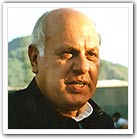 Many things he may be, but an administrator he isn't. It was under him that Kashmir finally slid into insurgency.
Many things he may be, but an administrator he isn't. It was under him that Kashmir finally slid into insurgency.
Dr Abdullah came to power in 1982 after his father's death in September. Politics was not his cup of tea. But the idea of power was. So he stuck to it.
He made a mammoth mistake when he tied up with the Congress for the 1987 assembly election. To the Kashmiris who have always seen Delhi as enemy number one, that was betrayal. To cap that, the National Conference brazenly rigged the polls. The Muslim United Conference, which had remarkable public support, lost. Result: youths became disillusioned with democracy and adopted other, violent means...
After six years, Dr Abdullah returned to the helm of a 'popular government' in 1996. Today, between playing polo, visiting foreign lands and threatening to resign, he does manage to hold on to his chair...
Ghulam Mohammad Shah

He was terribly unhappy when Sheikh Abdullah made Farooq his heir. The mantle, he felt, should rightfully have fallen on him -- after all, he was married to the sheikh's daughter and had been helping him in matters political.
Shah, a minister in Farooq's government, gave expression to his ambition by ganging up with the Congress. He plotted for two years. Finally, after collecting 11 MLAs, he staged a coup with active support from Governor Jagmohan. Farooq fell. Shah became CM.
The political instability he created, coupled with his non-existent administrative skills, was a healthy breeding ground for insurgency.
THE GOVERNORS
Jagmohan

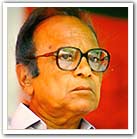
He probably contributed more to the conflict than any other governor.
A career bureaucrat (now a minister in the Union government), he was sent by Prime Minister Indira Gandhi for the express purpose of dethroning Dr Farooq Abdullah.
That assignment Jagmohan carried out to perfection on July 2 when he swore in G M Shah.
Jagmohan was governor for two terms. The first ended on July 11, 1989. He returned on January 19, 1990, when the state machinery had completely broken down. The very next day the Gawakadal massacre occurred. Kashmir began to burn even more fiercely with anti-India feelings.
Jagmohan is said to have unleashed a reign of terror. Narrow-minded but strong-willed, he is accused alternatively of saving Kashmir and worsening the situation beyond repair.
The exodus of Pandits is attributed to him. "He encouraged the migration. He wanted them out of the way so that he could have a clear field for strong-arm tactics," says a senior bureaucrat in Kashmir.
Ask him about Jagmohan, the administrator. Pat comes the reply: "Third-class!"
Yet, there are many who believe that Jagmohan did a commendable job. "He landed at a time when there was darkness in Kashmir administratively and politically. He somehow got the state machinery functioning. If it were not for him officials would still be functioning from Jammu. It was Jagmohan who got them to make the durbar move to Srinagar."
Jagmohan lost his job in May after security personnel fired upon Mirwaiz Maulvi Farooq's funeral procession. Over 50 people were killed that day.
Girish Chandra Saxena

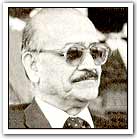
The former Research and Analysis Wing head replaced Jagmohan. If the latter was loud, the former believed in doing things quietly. But not very differently.
To Saxena's credit should go the rebuilding of the intelligence set-up.
When he left at the end of his first tenure, a functional network was in place.
Critics say that Saxena is not much different from Jagmohan in his approach to Kashmir. They believe that he made a grave error by ignoring a plea from 10 senior civil servants to involve the civil administration in tackling the situation. (By 1990 civil servants had been completely alienated.)
"Had the governor been prepared to listen there may have been a chance, even at this stage, to bring Kashmir from the edge..." writes journalist Tavleen Singh, "He refused even to try and see that he was dealing with a mass movement and not insurgency."
Like with Jagmohan, allegations of human rights violations were aplenty during Saxena's tenure. But the governor kept such a low profile that very little has been directly attributed to him.
Currently, he is on his second tenure in Srinagar.
General K V Krishna Rao

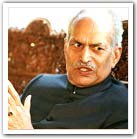
He also served two terms as governor like Jagmohan and Saxena.
The first is remarkable because it was then that militancy got an impetus via the Rubaiya incident; the second, because it was then that the movement was capped.
General Krishna Rao returned in March 1993 to take over from Girish Saxena. Being a former army chief he was able to co-ordinate better with the security personnel. Besides, he was close to Prime Minister Narasimha Rao and had Delhi's full support.
Krishna Rao, once the situation began to look up, pushed for an election. He felt a popular government would help. Finally, in 1996, elections were held.
The general yielded place to Saxena in 1998.
